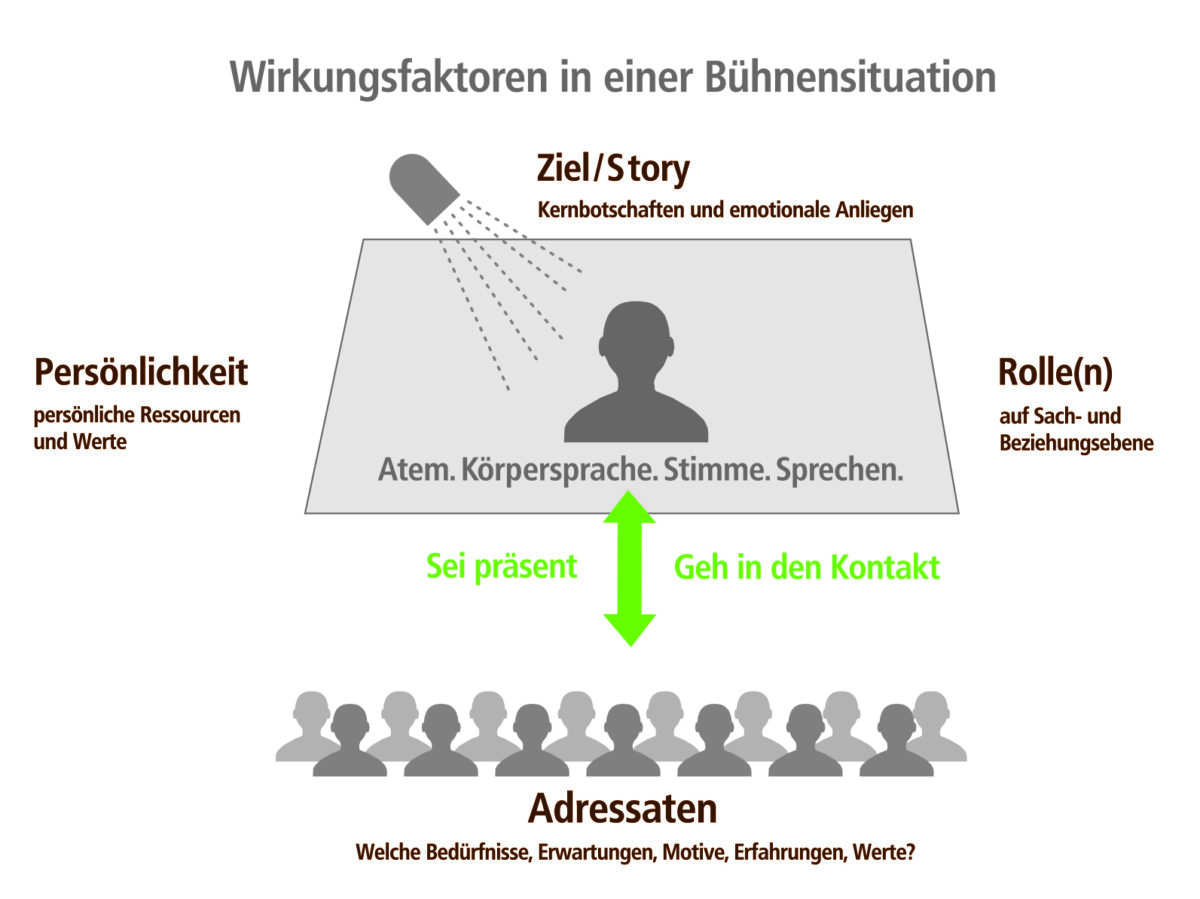Every business situation is basically a stage situation. No matter if it is a presentation, a customer meeting or a management situation:
- We are in front of an audience no matter how big or small.
- We are confronted with different needs and expectations.
- We want to communicate something, convince, convey.
- We have to make an appearance – preferably confident and authentic.
- We have to deal with unpredictable reactions and events.
Theater-based methods work because...
- …they activate and leave vivid images in the minds of the participants through the use of professional actors.
- …they make it possible to directly experience and shape individual behaviors and their effects in a protected rehearsal space.
- …they open the view on the “inner theater” and the individual needs of all stakeholders.
- …communication begins in the body, not in the head.
- …they are developed individually for the specific daily business of the participants.
Tools of stage professionals
In order to act confidently and credibly on the business stage, i.e. to open up resonance spaces for the counterpart, three basic skills are needed from the toolbox of actors and directors. This is exactly where we start:
- Presence and impact skills, including a clear understanding of one’s own role.
- Storytelling instead of facts and figures, i.e. using words to create images in the mind.
- The art of improvisation and the acceptance of the unpredictable.
Our team of actors and business experts supports you and your company with theater-based methods in leadership development, with business theater interventions at events and through e-learning offers – tailored to your training goals.
Research and literature on the effectiveness of theater-based training
In organizational consulting and management research, the effectiveness of art- and theater-based intervention formats for the optimization of work processes and internal forms of communication is continuously being studied and proven.
Berit Sandberg, Dagmar Frick-Islitzer: Die Künstlerbrille. Was und wie Führungskräfte von Künstlern lernen können. (Springer Gabler) Wiesbaden 2018.
The book shows how artists’ work processes work, how artists develop ideas and overcome crises. It presents a set of attitudes that are typical for professional artists and helpful for managers.
Managers are given concrete suggestions on how to acquire appropriate skills themselves. An exercise section makes it easy to try out all the attitudes covered.
Carsten Baumgarth/Berit Sandberg (Hg.): Handbuch Kunst-Unternehmens-Kooperationen. (transcript-Verlag, Bielefeld 2016.)
More and more companies are trying to meet operational and market challenges with the help of art. This handbook shows how artists shape brands, products and corporate communication, how they intervene in human resource management and organizational development, and how they support innovation processes.
Biehl-Missal, Brigitte: Wirtschaftsästhetik. Wie Unternehmen die Kunst als Inspiration und Werkzeug nutzen. Wiesbaden: Gabler Verlag 2011.
Biehl-Missal sheds light on the use of corporate theater in a large chapter in the first German standard work on “business aesthetics.” She provides an overview of the variety of forms of theater in companies, from presentation training, role-playing and improvisational theater to interactive forum theater.
Lisa Denneler: Einblicke in die deutsche Unternehmenstheaterlandschaft. Bachelorarbeit. Ludwigsburg 2012.
In her bachelor’s thesis at the Ludwigsburg University of Education, Lisa Denneler examines the production and impact of theatrical means that companies are increasingly using in the context of their organizational and human resources development. What is corporate theater? Who offers corporate theater? Where, how and why is corporate theater used?
“Das Andere”: Ästhetisch-performative Zugänge innovativer Organisations- und Arbeitsgestaltung. präview. Zeitschrift für innovative Arbeitsgestaltung und Prävention. Heft Nr. 1/2011
In various contributions, work and organization researchers, art and cultural scientists shed light on the “different” way of dealing with innovation pressure, complexity and indeterminacy, as they have become daily challenges in the management of organizations.
Heindl, A. (2007) Theatrale Interventionen – Von der mittelalterlichen Konfliktregelung zur zeitgenössischen Aufstellungs- und Theaterarbeit in Organisationen. Heidelberg: Carl-Auer-Systeme
Heindl examines the increasing use of theater in organizations and emphasizes that only “high-quality corporate theater that works sincerely with the people involved” will be able to succeed in the marketplace.
The book provides a sound basis for understanding and working with theatrical interventions in organizations. It provides orientation and opens up suggestions, new approaches and ideas for practical use.
Schreyögg, G. & Dabitz, R. (Hg.) Unternehmenstheater: Formen, Erfahrungen, erfolgreicher Einsatz. Wiesbaden: Gabler Verlag
Various authors explain the concept, form, occasion, purpose and effect of the use of theater in companies. An empirical study is used to provide a practical overview of the German corporate theater industry.
Teichmann, Stefanie (2001): Unternehmenstheater zur Unterstützung von Veränderungsprozessen. Wirkungen, Einflussfaktoren, Vorgehen. Deutscher Universitäts-Verlag.
Stefanie Teichmann examines the extent to which customized corporate theater can make a meaningful contribution to the implementation of planned changes. The focus is on the analysis of two detailed case studies.

